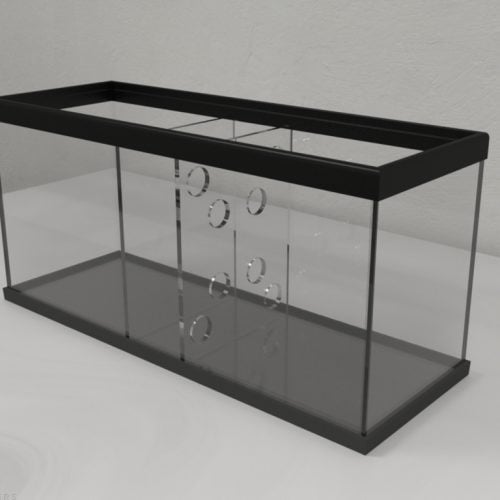The Zebrafish is a versatile animal model that is a common organism used in research. Much like the Drosophila animal model, Zebrafish are also popularly used in genetic screenings due to highly conserved genes and critical pathways between the species and humans. In comparison to traditional research animals, such as rats and mice, Zebrafish offer many technical advantages. The popularity of this model is due to its optical clarity and rapid embryonic development outside the mother which facilitates genetic studies. Zebrafish are hardy creatures that are easy to maintain in a laboratory set-up and are inexpensive.
Zebrafish Behaviors and Characteristics
|
Scientific Classification Scientific Name Family Name
|
: : |
Danio rerio Cyprinidae |
| Habitat | : | Zebrafish live in freshwater streams and rivers. They are most often found in shallow, slow-moving water near the edge of streams or in ditches that have sandy substrates. |
| Length | : | In captivity Zebrafish rarely grow beyond 4 cm. In the wild, the fish can grow up to 6.4 cm in length. The fish are 1 cm wide. |
| Diet | : | Omnivorous |
| Life Span | : | 2 to 5 years in captivity under ideal conditions. |
| Reproduction
Sexual Maturity Gestation Period |
: : |
10 to 12 weeks Less than 24 hours |
| Social Behavior | : | Adult Zebrafish are robustly social animals exhibiting shoaling and schooling behaviors among other behaviors. |
| Other behaviors & characteristics | : | ● Zebrafish have regenerative abilities
● Male Zebrafish have torpedo-shaped bodies with gold stripes between the blue stripes. ● Female Zebrafish have a larger, whitish belly and silver stripes instead of gold. ● Adult females exhibit a small genital papilla in front of the anal fin origin. |
History
Zebrafish were first described by Francis Hamilton (Hamilton, Baird, & Swaine, 1822) as natives of the Indian floodplains living in diverse water habitats. Zebrafish were eventually introduced in Europe in the early 1900s as pet fishes and rose to popularity due to their beautiful diversity and ease of care. The introduction of species in the United States is believed to be the result of a deliberate release or by escape from fish farms.
In the 1930s, Charles Creaser began advocating the use of the fish in student laboratories and experimental research (Creaser, 1934). Though the 1940s to 1960s did see the use of Zebrafish in a range of research applications (Battle & Hisaoka, 1952; Hisaoka & Firlit, 1962; Weis, 1968), it wasn’t until the 1970s that the Zebrafish grew in fame. The most notable contribution to the popularity of the Zebrafish animal model was by American molecular biologist, George Streisinger. Streisinger, along with his colleagues at the University of Oregon, ventured out to find a vertebrate animal model that offered a better understanding in genetic research (Varga, 2018). One of Streisinger’s earliest research resulted in the creation of Zebrafish clones that were among the earliest successful vertebrate clones created (Streisinger, Walker, Dower, Knauber, & Singer, 1981). His work using Zebrafish (Chakrabarti, Streisinger, Singer, & Walker, 1983; Streisinger, 1984; Streisinger, Coale, Taggart, Walker, & Grunwald, 1989; Walker, & Streisinger, 1983) laid the foundation for Zebrafish animal model and earned him the title of founding father of Zebrafish Developmental and Genetic Research.
The success of Zebrafish animal model received another push when Christiane Nüsslein‐Volhard (Haffter et al., 1996) and Wolfgang Driever (Driever et al., 1996) performed genetic screens of Zebrafish with the aim to find pathways with deeper homology to key pathways in human development. Labeled “Big Screens,” Nüsslein‐Volhard’s screening involved the use of the chemical mutagen ethylnitrosourea (ENU) to mutagenize male sperm. The resulting mutant Zebrafish included mutations at approximately six hundred independent genetic loci. A special issue of the Development published the categorization and descriptions of 1163 mutant lines from the Big Screen in their 1996 journal publication. The Big Screen eventually aided the completion of genome sequencing of the Zebrafish in 2013 (Howe et al., 2013).
Training Considerations and Best Practices
As with any animal model, Zebrafish also require specific care and maintenance to ensure their well-being and extract their full potential for research. Zebrafish are hardy animals that are relatively easy to rear and maintain in a laboratory facility. The following are a few considerations and practices for using Zebrafish for research purposes. (To know more about zebrafish testing click here.)
- The ideal temperature for Zebrafish is between 26 °C and 28.5 °C with a pH between 6.8 and 7.5. The pH can be balanced by the addition of sodium bicarbonate.
- Zebrafish can be sensitive to chlorine and other chemicals. Therefore, the tank water should be dechlorinated either by aeration or a dechlorinating water conditioner.
- Tank water should be regularly changed and filtered to maintain water quality. Water lost due to evaporation should be replenished.
- It is recommended that the Zebrafish be habituated to the facility before being tested to avoid the stress of novelty. Additionally, stressors should be minimized as much as possible to prevent their influence on the subject’s behaviors.
- Zebrafish are social animals; hence they should be maintained in shoals to avoid isolation stress.
- Overfeeding of Zebrafish could result in increased levels of nitrate in the water and potentially affect the breeding and viability of the fishes.
- Breeding of the fishes should be undertaken regularly to ensure the breeding cycle of the fish is maintained. The optimal breeding conditions for Zebrafish is between 3 and 18 months.
- Feeding of larvae should begin from day 5 post-fertilization on dry diets and/or live foods such as paramecia or rotifers.
Zebrafish in Research
Zebrafish is one of the most sought-after animal models to study gene function along with the Drosophila melanogaster. The ability to create gene knockdown or overexpression in addition to the almost transparent embryos have allowed acceleration of genetic studies. About 70% of protein-coding human genes and 84% of known genes associated with human diseases have been found to have homologs in the Zebrafish (Howe et al., 2013; Kettleborough et al., 2013). Zebrafish cover a range of research domains including regeneration studies, drug testing and screening, and cancer research.
Pharmacology and Toxicology Research
Kim et al. (2018) investigated the possible toxic effects of Triclosan on the neurodevelopment of fetuses and infants. Triclosan is a commonly used antimicrobial that has applicability in a range of products including hygiene and cosmetics. Its effects on neural development were observed using Zebrafish models including HuC-GFP and Olig2-dsRED transgenic cohorts. Kim et al.’s research showed that exposure to Triclosan during neurodevelopment resulted in a decline of survival rate, hatching rate, and heartbeats in a dose-dependent manner with effects most prominent at the highest dose. Developmental abnormalities were also observed to increase as the dose of Triclosan increased. In addition to morphological changes such as decreased body length, head size, and eye size, Triclosan exposure also caused apoptosis at cranial and caudal part of the brain and spinal cord. In HuC-GFP and Olig2-dsRED Zebrafish, a decrease in both the axon length and the density of synapse formed was observed on treatment with Triclosan.
Investigation of deliriant hallucinogens by Volgin, Yakovlev, Demin, Alekseeva, and Kalueff, (2018) revealed behavioral sensitivity of adult Zebrafish to the drugs. Volgin et al. evaluated sociability and anxiety behaviors of the fishes treated with varying doses of either atropine and scopolamine. Performances in the Novel Tank Test (see also Vertical Tank Array) showed that at a dose of 90 mg/L, atropine mildly increased swimming velocity and distance traveled, while 120 mg/L scopolamine resulted in significantly altered behaviors such as fewer top entries and longer latency to the top. The Novel Tank Test results suggested atropine led to hyperlocomotor while scopolamine resulted in mild anxiogenic and hypolocomotor behaviors. However, anxiety-related behaviors in the Light-Dark box between either treatment groups and controls did not significantly vary. When it came to sociability, both treatment groups had an increased fish distance in the shoaling test suggesting disrupted shoaling behaviors.
Ochratoxins are frequently found contaminating food such as cereals, coffee, and wine. Studies have linked ochratoxin A exposure to renal diseases in humans including Balkan endemic nephropathy and chronic interstitial nephropathy (Bui-Klimke, & Wu, 2015). The hepatotoxic effect and associated mechanism of ochratoxin A were revealed by Wu et al. (2018) using the Zebrafish animal model. In order to investigate the effects of ochratoxin A and aflatoxin B1, embryos of wild-type AB strain and Tg(LFABP:EGFP) with fluorescence in hepatocytes zebrafish were exposed to various concentrations at 6-hours post fertilization. Exposure to ochratoxin A at doses more than 0.25 μM resulted in pericardial edema and dark yolk sac at 96-hours post fertilization. Ochratoxin A treatment also led to a two-fold decrease of genes involved in hemostasis and blood coagulation in addition to blocking the expression of hhex and prox1 genes in the liver area.
Learning and Memory Research
Using a Fish Tank Radial Maze (see also 5-Choice Chamber and 3-Choice Chamber), Faillace, Pisera-Fuster, and Bernabeu (2018) observed that novel environmental cues facilitated drug-environment associations in Zebrafish. The study aimed to understand the factors playing into drug abuse; to investigate this the subjects were conditioned to either nicotine or caffeine in pre-selected arms by confinement. Following conditioning, subjects were tested under different conditions of novelty wherein a previously unexposed arm(s) of the 5 choices was made available. To further enhance novelty, the novel arms had colors that the Zebrafish tend to avoid while the other arms had either neutral response evoking or attractive colors. Nicotine conditioned fishes were observed to spend a significant amount of time in the drug-paired arm regardless of the tank conditions (introduction of novelty). However, such significance in behaviors was not attained in caffeine conditioned fishes. Additionally, the administration of phenylbutyrate (histone deacetylase inhibitor) prevented nicotine conditioned place preference with no such effect in the caffeine group.
Naderi, Salahinejad, Ferrari, Niyogi, and Chivers (2018) treated Zebrafish with different concentrations (3, 10, 30, and 60 µg/g dry weight) of dietary L-selenomethionine for a period of 60 days and evaluated performances in a Plus Maze using associative learning paradigm (see also Associative Learning Chamber and T-Maze). The behavioral test assessed how well the fishes learned to associate the visual cue with reward, which in this case was a shoal of six fish having the same origin as the subject. Selenium diet resulted in a significant impact on the performances of the fishes. Fishes exposed to selenium at all dose levels had a lower percentage of time spent in the target arm as well entered the target arm far fewer times than the control. Within the different treatment groups, a significant difference in the number of incorrect arm entries was also observed. Further analysis of the treated fishes showed that chronic dietary exposure to selenium affected dopamine synthesis, release, uptake, and receptor activation as a result of oxidative stress. It was also observed that selenium down-regulated genes involved in neural plasticity and memory formation.
A dose-dependent effect of methylene blue on the memory of Zebrafish was observed by Echevarria, Caramillo, and Gonzalez-Lima (2016) in a Bifurcating T-Maze (see also Larvae T-Maze) task. Fish were trained to swim into a specific arm that resulted in food reward for creating an arm-reward association in the T-Maze. Following training, the fishes were treated with either 0.1, 0.5, 5.0, or 10.0 µM dose of methylene blue or contained in blue colored water. Memory assessment in the T-Maze showed that at a lower dose (0.5 µM) the memory retention of the fishes was significantly better than the higher dose groups. Fishes treated with the highest dose were observed to perform significantly worse among the treated groups. However, 5 µM dose treatment did not result in any notable observation and fishes performed quite like the control fish.
Sheng et al. (2016) were able to observe a significant effect of TiO2 nanoparticles on the memory of the Zebrafish. Products containing engineered titanium nanoparticles are in wide use and can potentially result in the direct or indirect release into aquatic environments. In an effort to understand the neurotoxic effects of TiO2 nanoparticles on aquatic animals, Sheng et al. evaluated the performances of Zebrafish treated with 5, 10, 20, and 40 µg/L TiO2 nanoparticles in a Y-Maze (see also variants Y-Maze Avoidance and Y-Maze flow modification) task. It was observed that in comparison to the controls, the treated fishes had a lower percentage of time spent in the novel arm of the maze following an inter-trial interval. Based on these finding it was concluded that at low and sub-chronic exposures, TiO2 nanoparticles resulted in impaired spatial recognition memory in the fishes.
Vision and Retina Research
Howe, McIntyre, and Wolman (2018) evaluated the reliance on different sensory modalities by the Zebrafish when foraging. Howe et al. tested adult Zebrafishes’ predation behaviors using a Prey Capture Arena in which larvae were used as the preys. Sensory system manipulations included by either ablation of the lateral line hair cells (mechanosensory function), ablation of the olfactory epithelium (olfactory system function) or both, to assess the dependence on the visual system during foraging. It was observed that under full light conditions there were no effects on prey capture rates. However, under dark conditions, the rate reduced for all groups including controls. Further assessment performed by manipulating the contrast between prey and the background under light conditions resulted in a reduction of prey capture success under low contrast (black background) as opposed to high contrast conditions (white background). Taken together the results suggested a strong role of the vision system in foraging behaviors of Zebrafish.
Disruptive reproductive and thyroid effects of bisphenol S are well research (Naderi, Wong & Gholami, 2014), though its effect on the visual system is yet to receive attention. The disruptive effects of bisphenol S on the visual system was evaluated by Liu et al. (2017) using Tubingen type adult Zebrafish. Cleaned embryos between 0 and 2-hours post‐fertilization were exposed to either 0, 1, 10, 100 and 1000 μg l-1 bisphenol S concentrations for 120 days. Adult male Zebrafishes from each group underwent the Optokinetic Response test and the Optomotor Response Test. At contrast ratio of 0.3, the 100 μg l-1 concentration group had a significantly lower optokinetic response gain value than the solvent control group. Significantly lower optokinetic response gain value in comparison to the solvent controls was also observed at 0.6 or 0.9 contrast ration in 100 and 1000 μg l-1 dose group. Concordance ratio in the Optomotor Response Test for 100 and 1000 μg l-1 did not significantly change when the stripes of the drum were rotated counter-clockwise. However, clockwise rotation set-up in the 1 and 10 μg l-1 revealed a significant decrease in the concordance ratio after exposure to various concentrations of bisphenol S for 120 days.
Jia et al. (2017) made use of a color preference paradigm to evaluate the functionality of photoreceptors in Zebrafish treated with acrylamide. Male Zebrafish were treated with 2 mM of acrylamide dissolved in water for 36 hours. Following exposure, all fishes including controls were moved into a tank of system water for 15 minutes after which they were evaluated in the Color Preference Chamber (see also Place Preference Chamber) under 3 pairs of lighting conditions (blue-red, blue-white and red-white). The controls showed a preference for the colors in the order blue, white and red. However, such color preference could not be observed in the treated fish; The treated fish remained in the compartment that they were placed in. Further analysis via histological and histoimmunostaining assays of treated Zebrafish retinal structure revealed a significant reduction in the number of rod nuclei in addition to shortened outer segments of the rod cells. The cones were also found to be disorganized, and a significant reduction in the length of the double cones was also observed in the acrylamide exposed fishes.
Stress and Anxiety Research
Zahid et al. (2018) investigated the anxiolytic effects of diazepam in Zebrafish larvae. The investigation involved treatment of the larvae to either 0.25 μM (low concentration) and 2.5 μM (high concentration) of diazepam for 45 minutes once during the behavioral session. The preference testing arena was a petri dish that had its bottom divided into half black and half white (see also Black/White Preference Test). Diazepam treated fishes were observed to have increased thigmotaxis and had reduced preference for the black side of the petri dish in comparison to the controls. However, further analysis based on swim path parameters suggested the behaviors were resultant of diazepam-induced altered motor function rather than anxiety-based responses. Diazepam treatment was also observed to reduce swim speed and intra-individual temporal variance of turn angle. Overall, Zahid et al.’s investigation was unable to find alteration of diazepam-induced anxiety behaviors.
Audira et al.’s (2018) investigation using leptin a (lepa) knockout Zebrafish revealed the critical role of lepa gene in modulating anxiety, aggression, fear, and circadian rhythm behaviors. Non-appetitive behaviors of the lepa knockout fishes were compared with controls in a range of behavioral assess including shoaling, color preference and mirror biting (see variants Mirror Biting Balzarini and Mirror Biting Elwood). The lepa knockout Zebrafish displayed locomotion activity and speed that was significantly higher than the wild type controls in the Novel Tank exposure test. Further, the fishes also had a lower freezing time movement ratio than the controls. Analysis of catecholamine and cortisol levels by ELISA revealed a three-fold decrease and 1.5-fold increase in the levels respectively in the knockout fishes. A two-fold increase in the intracellular reactive oxygen species level and a 22-fold reduction of antioxidative stress enzyme of catalase was also observed along with the significant elevation of HIF‐1α level in the muscles of the lepa knockout fishes.
Environmental enrichment has been considered as a possible treatment to ameliorate the effects of stress. Marcon et al. (2018) were able to observe the reduction of vulnerability and the biochemical impact of stress in Zebrafish. Fishes either were housed in standard tanks or environmentally enriched tanks (see also Environmental Enrichment Chamber) that had gravel in the bottom, a ruin-like plastic object and three submerged plastic plants. Fishes were then further divided into stressed and non-stressed cohorts. Stressors included, heating tank water up to 33 °C (30 min), exposure to the predator (50 min), cooling tank water to 23 °C (30 min), crowding of 12 animals in a 300-mL beaker (50 min), transferring the animals to other tank with low water level exposing the dorsal body wall (2 min), tank change, three consecutive times with 30-min interval, and chasing with a net (8 min). Environment enrichment resulted in attenuation of the anxiogenic effect of unpredictable chronic stress as observed from the performances of the fishes in the Novel Tank. Further, the effects of the stressors on cortisol and reactive oxygen species levels were also attenuated by environmental enrichment.
Strengths and Limitations
Strengths
Zebrafish’s unique characteristics offer many advantages over traditional animal models such as rats and mice. The most interesting of these characteristics is that the embryos develop outside the mother’s body. Also, both the embryo and the larvae of the Zebrafish are almost transparent. This transparency allows observation of morphological changes during the development and the use of naturally fluorescent proteins to mark cells, organs, and organelles. The feature also minimizes the need for invasive procedures which in-turn reduces unnecessary stress from affecting the animal.
Just like Drosophila melanogaster, Zebrafish also serve as an ideal animal model for gene-based research. Zebrafish produce a large number of offspring in each generation which grows and develops very quickly which facilitates genetic studies. Further, the embryos easily absorb chemical, thus allowing gene mutations using chemical mutagens. In comparison to rodents, the tolerance level of Zebrafish to chemical mutagens is significantly higher. Cell biology and developmental processes are far more conserved between Zebrafish and humans than between humans and Drosophila melanogaster. An estimated 70% of protein-coding human genes and 84% of known genes associated with human diseases have been found to have homologs in the Zebrafish.
Given their small size, the housing and rearing of Zebrafish in a laboratory set-up is relatively easy and inexpensive in comparison to small and large animal models. Zebrafish also readily breed. The model also is associated with fewer ethical concerns.
Limitations
Though Zebrafish and humans share a lot of similarities, they cannot be used as a cohesive model for all human pathologies and other human-related diseases and behaviors. Zebrafish are physiologically and anatomically different from humans. Thus, extrapolation of data such as results from drug screening should be done with the utmost care and considerations. The presence of the chorion up to 48-hours post fertilization can potentially affect drug permeability. The rapid development of the embryo requires the need to stage the development phase precisely when used in acute assays.
Zebrafish are also very social animals that prefer staying shoals. Thus, isolation of the fish for long periods can result in unnecessary stress and affect the accuracy of data obtained. Maintenance of tank conditions is also crucial to ensure the well-being of the fishes. Zebrafish can be sensitive to chlorine and other chemicals, therefore, apart from maintaining optimal temperature and pH values of the water, the tank water should be dechlorinated. Habituation of the Zebrafishes to the facility should be undertaken prior to any testing to avoid stress from novelty. Regular breeding of the fishes should also be undertaken to maintain the breeding cycle.
References
Ali, S., Champagne, D. L., Spaink, H. P., & Richardson, M. K. (2011). Zebrafish embryos and larvae: a new generation of disease models and drug screens. Birth Defects Research. Part C, Embryo Today. 2011 Jun;93(2):115-33. doi: 10.1002/bdrc.20206.
Audira, G., Sarasamma, S., Chen, J.-R., Juniardi, S., Sampurna, B., Liang, S.-T., … Hsiao, C.-D. (2018). Zebrafish Mutants Carrying Leptin a (lepa) Gene Deficiency Display Obesity, Anxiety, Less Aggression and Fear, and Circadian Rhythm and Color Preference Dysregulation. International Journal of Molecular Sciences, 19(12), 4038. doi:10.3390/ijms19124038
Avdesh, A., Chen, M., Martin-Iverson, M. T., Mondal, A., Ong, D., Rainey-Smith, S., …, Martins RN. (2012). Regular care and maintenance of a zebrafish (Danio rerio) laboratory: an introduction. Journal of Visual Experiments, (69):e4196. doi: 10.3791/4196.
Battle, H. I., & Hisaoka, K. K. (1952). Effects of ethyl carbamate (urethan) on the early development of the teleost Brachydanio rerio. Cancer Research,12(5):334-40.
Bui-Klimke, T. R., & Wu, F. (2015). Ochratoxin A and human health risk: a review of the evidence. Critical Reviews in Food Science and Nutrition, 55(13):1860-9. doi: 10.1080/10408398.2012.724480.
Chakrabarti, S., Streisinger, G., Singer, F., & Walker, C. (1983). Frequency of gamma-Ray Induced Specific Locus and Recessive Lethal Mutations in Mature Germ Cells of the Zebrafish, BRACHYDANIO RERIO. Genetics, 103(1):109-23.
Creaser, C. W. (1934). The Technic of Handling the Zebra Fish (Brachydanio rerio) for the Production of Eggs Which Are Favorable for Embryological Research and Are Available at Any Specified Time Throughout the Year. Copeia,1934(4), 159. doi:10.2307/1435845
Driever, W., Solnica-Krezel, L., Schier, A. F., Neuhauss, S. C., Malicki, J., Stemple, D. L., …, Boggs C. (1996). A genetic screen for mutations affecting embryogenesis in zebrafish. Development,123:37-46.
Echevarria, D. J., Caramillo, E. M., & Gonzalez-Lima, F. (2016). Methylene Blue Facilitates Memory Retention in Zebrafish in a Dose-Dependent Manner. Zebrafish, 13(6):489-494.
Faillace, M. P., Pisera-Fuster, A., & Bernabeu, R. (2018). Evaluation of the rewarding properties of nicotine and caffeine by implementation of a five-choice conditioned place preference task in zebrafish. Progress in Neuropsychopharmacology and Biological Psychiatry, 84(Pt A):160-172. doi: 10.1016/j.pnpbp.2018.02.001.
Haffter, P., Odenthal, J., Mullins, M. C., Lin, S., Farrell, M. J., Vogelsang, E., …, Nüsslein-Volhard C. (1996). Mutations affecting pigmentation and shape of the adult zebrafish. Development Genes and Evolution, 206(4):260-76. doi: 10.1007/s004270050051.
Hamilton, F., Baird, S. F., & Swaine, J. (1822). An account of the fishes found in the river Ganges and its branches. doi:10.5962/bhl.title.59540
Hisaoka, K. K., & Firlit, C. F. (1962). The localization of nucleic acids during oogenesis in the zebrafish. The American Journal of Anatomy, 110:203-15.
Howe, H. B., McIntyre, P. B., & Wolman, M. A. (2018). Adult zebrafish primarily use vision to guide piscivorous foraging behavior. Behavioural Processes. doi:10.1016/j.beproc.2018.10.005
Howe, K., Clark, M. D., Torroja, C. F., Torrance, J., Berthelot, C., Muffato, M., …, Stemple, D. L. (2013). The zebrafish reference genome sequence and its relationship to the human genome. Nature,496(7446):498-503. doi: 10.1038/nature12111.
Jia, L., Raghupathy, R. K., Albalawi, A., Zhao, Z., Reilly, J., Xiao, Q., & Shu, X. (2017). A colour preference technique to evaluate acrylamide-induced toxicity in zebrafish. Comparative Biochemistry and Physiology Part C: Toxicology & Pharmacology, 199, 11–19. doi:10.1016/j.cbpc.2017.01.004
Kettleborough, R. N., Busch-Nentwich, E. M., Harvey, S. A., Dooley, C. M., de Bruijn, E., van Eeden, F., …, Stemple, D. L. (2013). A systematic genome-wide analysis of zebrafish protein-coding gene function. Nature, 496(7446):494-7. doi: 10.1038/nature11992
Kim, J., Oh, H., Ryu, B., Kim, U., Lee, J. M., Jung, C. R., …, Park, J. H. (2018). Triclosan affects axon formation in the neural development stages of zebrafish embryos (Danio rerio). Environmental Pollution, 236:304-312. doi: 10.1016/j.envpol.2017.12.110.
Liu, W., Zhang, X., Wei, P., Tian, H., Wang, W., & Ru, S. (2017). Long-term exposure to bisphenol S damages the visual system and reduces the tracking capability of male zebrafish (Danio rerio). Journal of Applied Toxicology, 38(2), 248–258. doi:10.1002/jat.3519
Marcon, M., Mocelin, R., Benvenutti, R., Costa, T., Herrmann, A. P., de Oliveira, D. L., … Piato, A. (2018). Environmental enrichment modulates the response to chronic stress in zebrafish. The Journal of Experimental Biology, 221(4), jeb176735. doi:10.1242/jeb.176735
Meyers, J. R. (2018). Zebrafish: Development of a Vertebrate Model Organism. Current Protocols Essential Laboratory Techniques, 16(1). doi:10.1002/cpet.19.
Naderi, M., Salahinejad, A., Ferrari, M. C. O., Niyogi, S., & Chivers, D. P. (2018). Dopaminergic dysregulation and impaired associative learning behavior in zebrafish during chronic dietary exposure to selenium. Environmental Pollution, 237:174-185. doi: 10.1016/j.envpol.2018.02.033.
Naderi, M., Wong, M. Y., & Gholami, F. (2014). Developmental exposure of zebrafish (Danio rerio) to bisphenol-S impairs subsequent reproduction potential and hormonal balance in adults. Aquatic Toxicology, 148:195-203. doi: 10.1016/j.aquatox.2014.01.009.
Oliveri, A. N., & Levin, E. D. (2018). Dopamine D1 and D2 Receptor Antagonism During Development Alters Later Behavior in Zebrafish. Behavioural Brain Research. doi:10.1016/j.bbr.2018.08.028.
Parker, M. O., Annan, L. V., Kanellopoulos, A. H., Brock, A. J., Combe, F. J., Baiamonte, M., …, Brennan, C. H. (2014). The utility of zebrafish to study the mechanisms by which ethanol affects social behavior and anxiety during early brain development. Progress in Neuropsychopharmacology and Biological Psychiatry, 55:94-100. doi: 10.1016/j.pnpbp.2014.03.011.
Sarasamma, S., Varikkodan, M. M., Liang, S.-T., Lin, Y.-C., Wang, W.-P., & Hsiao, C.-D. (2017). Zebrafish: A Premier Vertebrate Model for Biomedical Research in Indian Scenario. Zebrafish, 14(6), 589–605. doi:10.1089/zeb.2017.1447
Saszik, S. M., & Smith, C. M. (2018). The impact of stress on social behavior in adult zebrafish (Danio rerio). Behavioural Pharmacology, 29(1), 53–59. doi:10.1097/fbp.0000000000000338.
Shams, S., Amlani, S., Buske, C., Chatterjee, D., & Gerlai, R. (2017). Developmental social isolation affects adult behavior, social interaction, and dopamine metabolite levels in zebrafish. Developmental Psychobiology, 60(1), 43–56. doi:10.1002/dev.21581.
Sheng, L., Wang, L., Su, M., Zhao, X., Hu, R., Yu, X., …, Hong, F. (2016). Mechanism of TiO2 nanoparticle-induced neurotoxicity in zebrafish (Danio rerio). Environmental Toxicology, 31(2):163-75. doi: 10.1002/tox.22031.
Streisinger, G. (1984). Attainment of minimal biological variability and measurements of genotoxicity: production of homozygous diploid zebra fish. National Cancer Institute Monograph, 65:53-8.
Streisinger, G., Coale, F., Taggart, C., Walker, C., & Grunwald, D. J. (1989). Clonal origins of cells in the pigmented retina of the zebrafish eye. Developmental Biology, 131(1):60-9.
Streisinger, G., Walker, C., Dower, N., Knauber, D., & Singer, F. (1981). Production of clones of homozygous diploid zebra fish (Brachydanio rerio). Nature, 291(5813):293-6.
Tavares, B., & Santos Lopes, S. (2013). The importance of Zebrafish in biomedical research. Acta Medica Portuguesa, 26(5):583-92.
Varga, M. (2018). The Doctor of Delayed Publications: The Remarkable Life of George Streisinger (1927-1984). Zebrafish, 15(3):314-319. doi: 10.1089/zeb.2017.1531.
Volgin, A. D., Yakovlev, O. A., Demin, K. A., Alekseeva, P. A., & Kalueff, A. V. (2018). Acute behavioral effects of deliriant hallucinogens atropine and scopolamine in adult zebrafish. Behavioral Brain Research, 359:274-280. doi: 10.1016/j.bbr.2018.10.033.
Walker, C., & Streisinger, G. (1983). Induction of Mutations by gamma-Rays in Pregonial Germ Cells of Zebrafish Embryos. Genetics, 103(1):125-36.
Weis, J. S. (1968). Analysis of the development of nervous system of the zebrafish, Brachydanio rerio. I. The normal morphology and development of the spinal cord and ganglia of the zebrafish. Journal of Embryology and Experimental Morphology, 19(2):109-19.
Wu, T. S., Lin, Y. T., Huang, Y. T., Cheng, Y. C., Yu, F. Y., & Liu, B. H. (2018). Disruption of liver development and coagulation pathway by ochratoxin A in embryonic zebrafish. Toxicology and Applied Pharmacology, 340:1-8. doi: 10.1016/j.taap.2017.12.012.
Zahid, H., Tsang, B., Ahmed, H., Lee, R. C. Y., Tran, S., & Gerlai, R. (2018). Diazepam fails to alter anxiety-like responses but affects motor function in a white-black test paradigm in larval zebrafish (Danio rerio). Progress in Neuro-Psychopharmacology and Biological Psychiatry, 83, 127–136. doi:10.1016/j.pnpbp.2018.01.012






























Social Development and Behavioral Research
Stress has been known to have an adverse effect on social behavior. Sazik and Smith (2018) evaluated the social behaviors of adult male and female Zebrafish post stress treatment. Treatment conditions involved isolation, overcrowding, low-dose ethanol, exposure to 1-methyl4-phenyl-1,2,3,6-tetrahydropyridine (MPTP) and exposure to MPTP before isolation. Following treatment, behaviors including nearest neighbor distance and swim ability were observed by introducing the treated fish to a shoal of control fish (see Sociability Chamber). Though no treatment adversely affected the locomotory abilities of the fishes, both stress and MPTP resulted in similar asocial behaviors. The increased distance between the treated and the nearest control fish suggest that stress possibly affects dopamine activity.
In another study, Oliveri and Levin (2018) observed behavioral alterations in the larval activity of Zebrafish that were embryonically exposed to D1 and D2 receptor antagonists. Zebrafish eggs of strains AB* and 5D were treated with 0.5 ml solutions halobenzazepine or haloperidol at either 0.5 or 1.5 µM in well plates with meshed plastic inserts. Larval locomotor activity was observed in the light-dark larval motility assay under 10 minutes of 5,000 lux illumination and 10 minutes at 0% illumination conditions. Analysis of the performances of larvae revealed strain and dose effects that were also influenced by the light conditions. Under the light conditions either dose of halobenzazepine resulted in significant hypoactivity of the larvae in comparison to the controls. At a dose of 1.5 µM halobenzazepine, AB* strain showed significantly reduced activity in the dark. However, larvae exposed to 0.5 and 1.5 µM haloperidol and 0.5µM halobenzazepine had significantly increased activity in the dark condition. When behaviors of adult AB* strain Zebrafish were evaluated in the Predator Stimulus Escape, dopamine antagonists led to decreased locomotor activity with significant reduction occurring at the highest dose of halobenzazepine. However, no effects of either antagonist could be observed in the Novel Tank Diving Test, Sensorimotor Startle Response Habituation, and Social Affiliation Test (see Cattelan’s Mirror Biting Chamber).
Abnormal social behaviors are indicative of several human brain disorders. Social behaviors can be heavily influenced by the social environments, with adverse early social environment resulting in long-lasting effects on the behavior and physiology. Shams, Amlani, Buske, Chatterjee, and Gerlai (2017) investigated the effects of early social isolation by subjecting zebrafish to either long isolation (day 0 to day 180 post-fertilization) or short isolation (day 0 to day 7 post-fertilization). The long-term isolation group traveled significantly longer distances and less time in the perimeter in comparison to the other group and the control in the Open-Field Test. Further, the long isolation group also had significantly more nearest neighbor distance in the shoal task.
Park et al.’s (2014) investigation into the effects of ethanol exposure during the gestation of Zebrafish resulted in progeny with anxiety and affected social behaviors. Tubingen Zebrafish embryos were treated with 20 mM ethanol in aquarium water at 48-hours post fertilization. Prenatally ethanol-exposed fishes were observed to spend a long time in the bottom third of the Novel Tank Diving apparatus and less time in the social zone in the Shoaling assay, suggesting a higher level of anxiety in comparison to the controls. Further, developmental mRNA expression analysis post ethanol exposure revealed transient up-regulation of slc6a4 at 72-hours post fertilization, and putative adaptive changes in oxtr and htr1aa expression. Taken together the results revealed the molecular basis of developmental ethanol exposure associated with social behavior.